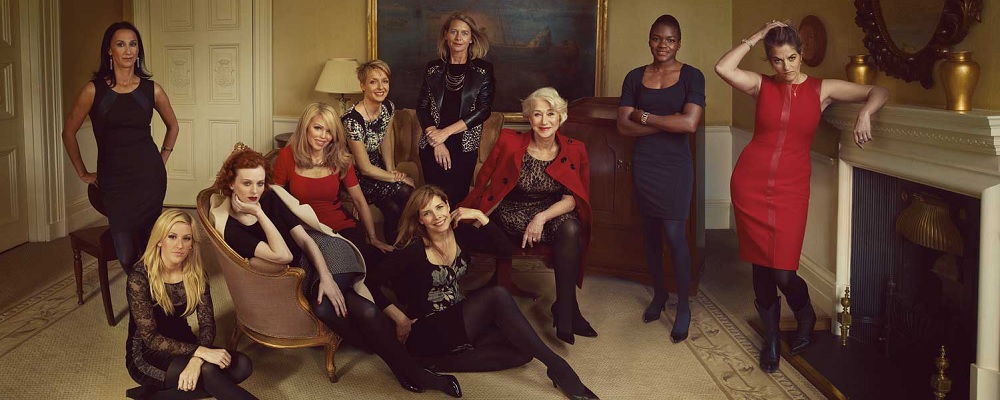When your local supermarket, department store or specialist retailer breaks a brand new ATL in November, you know the silly season is upon us. With so much revenue and profit generated during this quarter, you can understand why the stakes are high. Ads increase exponentially in prime time slots to lure us and retailers live off the hope that the shopping public will funnel hard earned CASH through their cash registers. Production values go up, a memorable ditty is sung and a plethora of celebrities smother the campaign, but do retailers really need to spend so much on celebrity endorsement? As a marketer, I fully embrace the necessity and understand the advertising value. I agree that prime time advertising slots are a must if you want to make an impact, as are production values, but based on the criticism generated by the lacklustre impact of Marks & Spencer’s “Leading Ladies” campaign, can retailers justify the expense?
In August, Annie Leibovitz shot and featured ten leading ladies, including Oscar-winning actress Helen Mirren and artist Tracey Emin, to drive sales in ladies’ fashion. Did the campaign need to be so “high budget”? The advert was beautiful and well-produced, but I can’t help but feel that the garments the ladies were selling were somewhat lost in the campaign’s fora. It was not great fashion and, to be honest, I doubt many women felt drawn to the concept that these leading ladies really dress in M&S, felt comfortable in what they were wearing or that M&S was back on trend. After all, the same women are usually sporting the latest designer labels down the red carpet. With Marks & Spencer posting its ninth consecutive quarter of declining clothing sales, the results certainly don’t live up to the celeb hype. Therefore, you’d believe a rethink was in order for the Christmas Peak – but not so. Rosie Huntington-Whiteley, David Gandy and Helena Bonham Carter (another Oscar winner) are featured, but I reserve my judgment on whether this will truly resonate with the average M&S shopper this time round.
From Waitrose to Debenhams and John Lewis (with its recently-released advert with Lilly Allen singing the Keane song, Somewhere Only We Know), retailers will spend, according to market analyses done by Nielsen, an estimated £390m on advertising over the final three months of 2013. That’s £128m more than retailer M&S reported in profit for the first six months of trading. But then again, John Lewis reported record sales last Christmas, showing that ads can work as long as you have the quality products to help close the loop.
SEE ALSO: At the Heart of Holiday Advertising
Brands in crowded categories may require celebrity endorsement to drive advocacy, but some do it better than others. Does retail foot traffic really require retailers to drive our emotions with the glamour of celebrities wearing, eating or commenting on the quality, style and taste of (what are really just) run-of-the-mill products? Moreover, how much of the campaign is devoted to the celebrity? I can’t imagine that the aforementioned Oscar-winning actresses are inexpensive; on the contrary, they are eating into an already squeezed margin. And do celebrities themselves truly embrace the brand enough to tap into its target audience? I doubt the M&S leading ladies of the summer are donning M&S’ A/W collection, even when they pop out for a pint of milk.
Some of the heavyweights have ditched celebrities this Christmas. Asda has slashed investment in its Christmas advertising campaign and blasted rivals’ “celebrity-filled” ads. The grocer has cut its budget by 10% and put value at the heart of its festive messaging. It has also been announced that the Tesco ad will not be celebrity-focused either. We shall see if they turn their savings this Christmas into profit.
Brands are increasingly defined by experiences, so the use of celebrities has to perpetuate the story and allow consumers to visualise the products as part of their lives. Celebrity ads have become ubiquitous. Marketers often scrap over celebrities for a chance to use their name. The need for standout means marketers are exploring new approaches to maximise the celebrity’s appeal. Some work, some fail and some remain unproven. Regardless of approach, the ad has to be credible and authentic.
For brands, such deals often give advertisers a direct line to celebrities’ fan followings via their personal Twitter accounts and Facebook pages. However, the true asset is a star’s relevance, buying a marketer the kind of buzzy exposure that only a Hollywood headliner can bring. The choice has to be right. So why have tech brands enrolled the world’s biggest stars to endorse cutting-edge tech products is anyone’s guess. Kevin Bacon for EE, Robert Downey Jr. for HTC and David Beckham for Motorola back in the day? I really can’t see the connections here – please, tell me if I’m wrong. Brand recall is vital, but let’s not forget the goal here: Revenue. While Beyoncé may drive me towards buying Pepsi, do I care which retailer I purchase it in?
No one will argue more than me that ATL campaigns are crucial. But I shall enjoy critiquing from my sofa the raft of celebrity appearances and voiceovers, which will grace my TV screen over the coming months. Perhaps, I will be congratulating my choice of viewing via Freeview+, which allows me to pre-record and fast forward past the ads to my favourite Christmas special. Then again, I may just hold out for John Lewis’ much-lauded Disney–inspired masterpiece.
Image source: TheInspirationRoom
